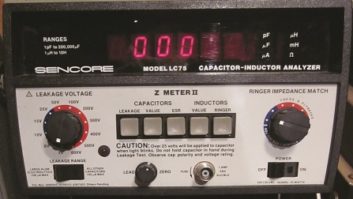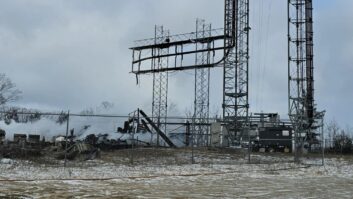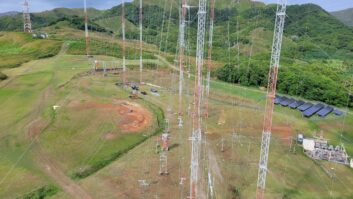These days, it seems that we could easily say “your transmitter is starving” for a number of reasons. It could be starving for maintenance, starving for a tube, starving for a good cleaning or even starving for a good clean power source.
Those are all important, but what I am writing about here is none of the above; your transmitter is starving for cool air. Don’t dismiss this as just another presentation on air conditioning maintenance, because we’re going to take this much deeper.
An age-old problem that we all face is keeping the transmitter cool, and I have seen a variety of approaches over the years that were implemented to solve this problem. It appears that years ago, transmitter sites were built with a lot of thought, calculations and planning; but now I run into more and more sites that were poorly designed from the beginning or that, though well-designed a generation ago, have degenerated through the years into a poor arrangement. I hope to refresh a couple of concepts that will help when designing a new facility or restoring a facility to its former good performance.
First, let’s briefly discuss a couple of common schools of thought on transmitter and building cooling.
The Heat Exhaust Method: In this method, transmitter heat is exhausted from the building by duct work directly from the exhaust port of the transmitter. The actual cooling of the building and cool air intake for the transmitter is provided by the building air conditioning. In my experience, this method is by far the most popular.
The Sealed Building Method: Here, as the name implies, the entire building is sealed completely. All air in the building remains in the building; the transmitter dumps all of its air right into the building.
Each method has pros and cons.
Heat Exhaust: Pros — Easier on the electric bill because a smaller air conditioning unit is needed. Cons — More building penetrations, which mean more dirt and bugs being actively drawn in by the negative air pressure in the building, and more humidity, causing corrosion and a variety of other related issues that I will discuss in a moment.
Sealed Building: Pros — A much cleaner environment with little to no ingress of dirt and bugs, which, in turn, will mean fewer purchases of building filters for AC and transmitter, etc. Cons — Will likely mean additional expense in the increased AC unit size as well as a higher monthly electric bill.
It really appears to be no contest on what method you’d choose. To save money, you would likely select the Heat Exhaust Method, right?
It might appear to be the winner initially, but I want to touch on several items that need to enter into your calculations when comparing the methods.
As you recall, the transmitter building will have a negative air pressure. If your transmitter is grabbing up all of your room air and shoving it outside, and since nature abhors a vacuum, it will seek to equalize pressure immediately. This means that more dust, pollen, dirt, bugs and moist air will find every hole, crack and crevice and ride that make-up air right into the building.

Fig. 1: Condensate forms on the top of the auxiliary transmitter because outside air is being drawn into the building from the transmitter’s exhaust duct.
You may say, “It’s not that big of a deal, because I come to the site weekly and sweep it out.” True, but here are some examples as to why it is a little worse than that:
One of my client’s sites has a main and a backup transmitter at the same transmitter site. They use the Heat Exhaust Method at the site. On a site maintenance visit on a hot day in Texas, I noticed some water on the top of the auxiliary transmitter, as seen in Fig. 1.
It didn’t take too long to see what was happening: Nature, abhorring that vacuum, was using the exhaust duct from the aux transmitter to bring in all of the make-up air to equalize the building pressure. Unfortunately, the warm moist air from the outside was being drawn in through the metal exhaust duct, being cooled by the indoor air conditioning, and was causing condensation to form and drip on and in the transmitter’s exhaust port, right down onto the tube, tube socket and everything in the general vicinity. Over time, this caused corrosion to the tube socket.
Another site visit yielded a different round of interesting observations.


Fig. 2: The temperature rises with the building door closed. Not enough outside air is entering the building.Fig. 3: Temp drops after the building door is opened, allowing more outside air to pass through the transmitter.
I was at the site for other, non-HVAC reasons, but when I go to sites, I like to take a general look around — a “mini preventive maintenance.” This time, my observations had me scratching my head: When I went in to the building initially, I observed that the exhaust temp, as read on the exhaust duct coming right out of the transmitter, indicated about 170 degrees (Fig. 2). I had observed this before in previous visits so I didn’t think too much about it. I needed to get some things from the truck and since it was a short walk, I went outside, leaving the door open. When I returned, before I closed the door, for some reason I looked at the exhaust temp again and was a bit shocked to see it was reading about 130 degrees (Fig. 3).
After some experimentation, I confirmed that when the door was open, the temp was lower. With the door closed the temperature shot back up. What had made the temperature change so radically?

Fig. 4: Condensate formed around the electrical box, caused by outside air entering through conduit and building openings.
There was the negative air pressure in the building being compounded by two large impelling blowers in the duct. With the door closed, the exhaust duct could not get enough air to pass through to reduce the temperature. Additionally, with negative air pressure in the room, the air is actually thinner, similar to what happens when ascend in altitude. As manufacturer Continental Electronics Corp. stated in its 816R-5C Technical Manual: “Negative pressure at the transmitter air inlet has the same detrimental effect as back pressure of the same amount at the transmitter air exhaust.”
Finally, there is one other potential side effect worth mentioning, since there is negative pressure in the building and nature abhorring a vacuum and all that, it will try to get make-up air in any way and from anywhere that it can. This includes, you guessed it, the power line portals for utility and generator feeds from the outside of the building. If it is hot and humid outside and nice and cool inside, what do you think will happen to the cool metal innards of the breaker panels, disconnects, junction boxes, transfer switch boxes and wire troughs — they will condensate, right? At one site, I opened up the panel and it was literally raining like a tropical forest on the inside (Fig. 4). What a hazard and what a mess! One might also argue the time and money spent on maintenance in a Heat Exhaust Method with more filter changing, sweeping dirt, dust and bugs weekly in addition to the extra strain placed on components inside the buildings.
As anecdotal success of the Sealed Building Method, one of my clients in the Shreveport, La., market was skeptical about changing from the Heat Exhaust Method. As it turned out, there was no need for an upgrade in AC capacity and the client noted the Sealed Building Method immediately kept the transmitter cooler and cleaner. This is one of a handful of happy results.
When I make HVAC recommendations to my clients or protégés, I opt for the Sealed Building Method every time.
Brian Heise, CPBE CBNT, is an independent broadcast engineer with a career spanning two decades in large- and small-market radio.












